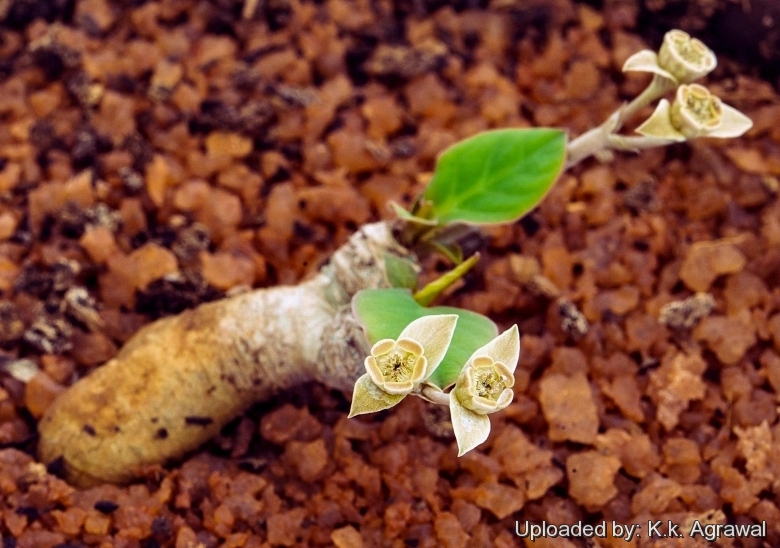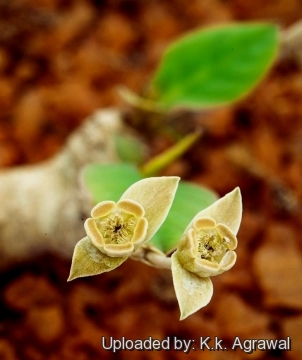




Your support is critical to our success.
- Encyclopedia of SUCCULENTS
- Encyclopedia Index
- Families
- Genera
- Species
- Euphorbiaceae
- Euphorbia
- Caudiciforms
Since 4 Aug 2013

Caudex and flowers.
Origin and Habitat: This species occurs only on some rocks in the south-east of the Tsingy of Ankarana : Andrafiabe (Camp des Américains) and Andavenoko. North Madagascar.
Habitat and Ecology: Humus on dry calcareous rock faces. The species is very rare and threatened by degradation, fire and collection for horticultural purposes. The area of occupancy and extent of occurrence are within the Réserve Spéciale de l’Ankarana.
Synonyms:
- Euphorbia labatii Rauh & Bard.-Vauc.
Description: Euphorbia labatiiSN|15541]]SN|31009]] is a geophyte, polymorphic dwarf species similar to Euphorbia moratiiSN|31009]]SN|15541]]. It forms a substantial caudex that can grow to about 4 centimetres in diameter, the whole plant to 25 centimetres height. The crown of leaves is preceded by a ring of small pinkish-white, green-yellow or coppery flowers. The leaves are attractive, elongate green on top with a light centre rib, burgundy underneath and wavy, crenate margins.
Derivation of specific name: The species name is dedicated to the French botanist Jean-Noël Labat (1959-2011), who worked with the flora of Mexico and was also a studious of the flora of Madagascar.
Caudex (rootstock): Tuberose, globose or cylindrical, to 4(-7) cm in diameter or 4-6 (or more) cm long, with brown, shaggy bark, merging into stem with branches below and at ground-level.
Branches: Up to 6 cm long, ca. 1 cm in diameter covered with leaf-scars.
Leaves: Crowded in apical rosettes, lanceolate, 4-6 cm long, 2-2.5 cm wide, base tapering into a petiole 1-1.5 cm long, margins undulate, red-rimmed, young leaves tinted violet beneath. Stipules lanceolate, ca. 3 mm long, scaly, deciduous.
Inflorescence (cymes): Subterminal, erect, 1- to 2-forked; peduncles 1.5 - 3 cm; cyathophylls deltoid, 7 long, 13 mm wide, pinkish-white, overlapping and covering but not enclosing the cyathia.
Flowers (Cyathia). 4 mm in diameter; nectar-glands yellow, oblong.
Fruits: Obtusely lobed, 4 mm in diameter, subsessile.
Note: Recently a new form known as "Red Leaf type" or "labatii type 2" from Antsiranana Province in Madagascar has been offered in trade. The leaves are wider, flatter and almost red. The flowers has significantly smaller petals. This somewhat enigmatic plant may be a different species.
Bibliography: Major references and further lectures
1) Urs Eggli “Illustrated Handbook of Succulent Plants: Dicotyledons” Volume 2. Springer, 2002
2) Haevermans, T. 2004. Euphorbia labatii. The IUCN Red List of Threatened Species. Version 2014.3. <www.iucnredlist.org>. Downloaded on 06 April 2015.
3) José Manuel Sánchez de Lorenzo‐Cáceres “Epónimos del género Euphorbia L.” Concejalía de Medio Ambiente. Servicio de Parques y Jardines Ayuntamiento de Murcia. 2013

Euphorbia labatii Photo by: K.k. Agrawal
The gallery now contains thousands of pictures, however it is possible to do even more. We are, of course, seeking photos of species not yet shown in the gallery but not only that, we are also looking for better pictures than those already present. Read More...
Cultivation and Propagation: Euphorbia labatiiSN|31009]]SN|31009]] is an interesting addition to a collection, but rarely seen in cultivation.
Growth rate: It grows well, though very slowly, but it possible to increase the speed of growth to some extent by providing adequate amount of water, warmth, and fertilizer during the active growing season, but it’s susceptible to rotting if too wet.
Exposure: It needs light shade, but the caudex should be in the shade, while the leaves prefer some sun. Avoid direct blasting sun in summer. Bright light if grown indoors.
Caudex exposure: The remarkable tuberous rootstock (caudex) is often raised above the soil line so that this can be seen and more readily appreciated. For best results the tuber must be exposed only when plans become mature enough, usually after several years (8-12 or more years) of underground growth, as the exposed caudex will no longer increase in size once it has been lifted above the soil line.
Soil: In pots it needs a very porous potting medium (add pumice, vulcanite, and perlite). It does better in a rather acidic soil.
Waterings: Water frequently while plant is in full growth, but keep dry during the winter after the branches have died back. It rot easily and do NOT like a lot of water when it has no leaves.
Fertilizer: Benefits from moderate doses of a well-balanced, slow-release fertilizer.
Frost tolerance: Due to its Madagascan origin keep warm in winter, the minimum safe average temperature is 15°C, although it can go lower for short periods. It can be grown outdoors in frost-free climates, need anyway to kept above 10°C and dry in winter. It is very prone to rot in cool, wet conditions. USDA Zone 10-12, but does very well in containers.
Manteinance: Repot every two years. It like pots with generous drain holes.
Pest and diseases: White meldew, mould and other fungi.
Propagation: The species can be propagated by both seeds and cuttings. The plants for seed production are generally grown from cuttings since these bloom more freely. The plants for decoration are grown from seed since they develop a caudex.
| Your Actions | |
|---|---|
| Back to Euphorbia index | |
| Back to Euphorbiaceae index | |
 |
Back to Succulents Encyclopedia index |
Privacy stantement - Terms and conditions - How to cite - About us - Feedback - Donate



